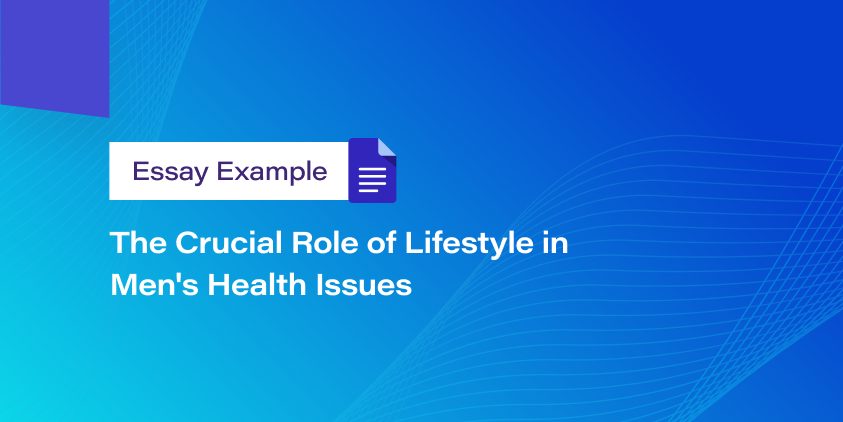The Crucial Role of Lifestyle in Men’s Health Issues

Today, several health issues affect men heavily and arise from various factors, including the environment and lifestyle conditions. However, most affect men over 40 (Lundy & Janes, 2016). Diseases have caused high mortality among men in the world. To reduce the mortality rate, community health nurses (CHNs) have a major role in disease prevention. They perform vital functions on the three prevention levels by targeting prostate cancer, testicular cancer, erectile dysfunction, and cardiovascular diseases, which greatly affect men.
Prostate cancer is a major threat to men. It affects males above 40 years old (Lundy & Janes, 2016). However, the disease is rare in young men (Lundy & Janes, 2016). Age determines vulnerability, whereby old persons are at a high risk. Pettersson et al. (2012) confirm that high-fat dairy products increase prostate cancer progression by suppressing 1, 25-dihydroxyvitamin D and elevating IGF-1 circulating levels resulting in the disease. Suppression and elevation increase the growth of tumorous cells significantly. As a result, age is a key determinant of prostate cancer.
Testicular cancer is another male issue. It affects men between the ages of 20 and 34, and socioeconomic status is a major determinant (Lundy & Janes, 2016). It is more common in white men than black and young men (Lundy & Janes, 2016). It means that prevalence levels are high in America and Europe. Cancer in young men develops due to undescended testicles, which increase their vulnerability to developing the disease. Shanmugalingam, Soultati, Chowdhury, Rudman, and Van Hemelrijck (2013) confirm that testicular cancer is common among boys born with undescended testicles in 3 out of 100 males. It occurs due to the failure of their testicles to attach to the scrotum. Men in the middle age tend to be at a higher risk than old men.
Erectile dysfunction (ED) is another special disease that affects men above 40 years. It is caused by smoking and unhealthy lifestyles (Lundy & Janes, 2016). The latter makes men develop obesity, which increases the disease’s chances. Reports indicate that males with high BMI tend to have erection problems (Pastuszak, 2014). Obesity alters testosterone hormones that facilitate erection. The suppression of the hormones results in reduced erection, leading to ED. As a result, unhealthy lifestyles contribute to the disease significantly.
Cardiovascular diseases (CVD) are the major causes of death among men today. A sedentary lifestyle and an unhealthy diet, such as consuming foods with high cholesterol levels, a major contributors to CVD (Lundy & Janes, 2016). A high intake of fats increases the level of saturated fats in the body, causing blockage to arteries and leading to hypertension. Reports indicate that daily losses due to CVD account for 33% of deaths among men (Jousilahti et al., 2016). It means that high death rates in men occur due to such diseases.
Community health nurses play an important role in the prevention of these diseases. On the primary level, they educate people on a healthy diet and the need for physical exercise to maintain their correct BMI (Lundy & Janes, 2016). It helps prevent men from developing diseases like CVD and ED, which are associated with an unhealthy lifestyle. Kim et al. (2016) confirm that CHNs use varying sizes of individual or group education sessions to sensitize to diseases that affect men. The sessions can be vital to behavior change and focus on healthy living. On the secondary level, nurses are responsible for the timely detection and diagnosis of men’s diseases. Finally, on the tertiary level, CHNs provide care for men with one of the diseases above, helping them to recover or alleviate symptoms.
In conclusion, men face serious illnesses mostly related to their lifestyle, contributing to high mortality. Prostate cancer is a major issue that arises from an unhealthy diet. Testicular cancer is another problem, the major cause of undescended testicles. Erectile dysfunction arises from various factors, including smoking. Cardiovascular diseases are caused by diet issues, especially the consumption of cholesterols. From the issues above, it is clear that community health nurses have a role in eradicating these problems by helping people to control their weight and lifestyle.
📎 References:
1. Jousilahti, P., Laatikainen, T., Peltonen, M., Borodulin, K., Mannisto, S., Jula, A., … Vartiainen, E. (2016). Primary prevention and risk factor reduction in coronary heart disease mortality among working-aged men and women in eastern Finland over 40 years: Population based observational study. BMJ, 353, i721. https://doi.org/10.1136/bmj.i721
2. Kim, K, Choi, J., Choi, E., Nieman, C., Joo, J., Lin, F., … Han, H. (2016). Effects of community-based health worker interventions to improve chronic disease management and care among vulnerable populations: A systematic review. American Journal of Public Health, 106(4), e3-e28. https://doi.org/10.2105/AJPH.2015.302987
3. Lundy, K. S., & Janes, S. (2016). Community health nursing: Caring for the public’s health (3rd ed.). Burlington, MA: Jones & Bartlett Learning.
4. Pastuszak, A. W. (2014). Current diagnosis and management of erectile dysfunction. Current Sexual Health Reports, 6(3), 164-176. https://doi.org/10.1007/s11930-014-0023-9
5. Pettersson, A., Kasperzyk, J., Kenfield, S., Richman, E., Chan, J., Willett, W., … Giovannucci, E. (2012). Milk and dairy consumption among men with prostate cancer and risk of metastases and prostate cancer death. Cancer Epidemiology, Biomarkers & Prevention, 21(3), 428-436. https://doi.org/10.1158/1055-9965.EPI-11-1004
6. Shanmugalingam, T., Soultati, A., Chowdhury, S., Rudman, S., & Van Hemelrijck, M. (2013). Global incidence and outcome of testicular cancer. Clinical Epidemiology, 5, 417-427. https://doi.org/10.2147/CLEP.S34430
